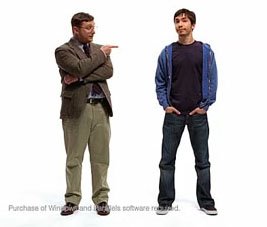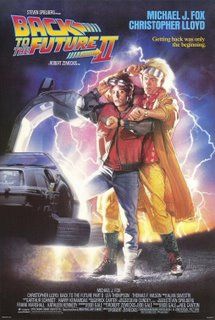Young, hip social networker, meet stodgy, traditional Banker.
 First, the creatively cool Mac and traditionally dull PC got together. Now, the trend continues.
First, the creatively cool Mac and traditionally dull PC got together. Now, the trend continues.
Almost as if they read it off the blog, Citigroup (the nation's 35th largest advertiser) struck a deal with MySpace today to begin advertising on the site. Details are still forthcoming, but it nonetheless proves significant. The shift to digital ads is picking up steam as its anticipated other large advertisers will follow suit.
In case you were looking for an additional resource to view the Information Revolution, paidContent.org is a useful site for tracking the business media and content.
X + Y = Δ
 How are Generations X & Y changing the consumer landscape? To start with, they are living in new ways via the Internet. They shop, network, research, download, learn, blog, entertain and express themselves online. As a result, large traditional retail outlets are losing market share to the nimble and niche players in the online universe. And amazingly, this is just the beginning of the Information Revolution.
How are Generations X & Y changing the consumer landscape? To start with, they are living in new ways via the Internet. They shop, network, research, download, learn, blog, entertain and express themselves online. As a result, large traditional retail outlets are losing market share to the nimble and niche players in the online universe. And amazingly, this is just the beginning of the Information Revolution.
As the Internet has become a new portal for X'ers and today's teens to extend and integrate their lives, companies are scurrying to find creative ways to reach them as traditional means of marketing and advertising are losing their effectiveness. Rupert Murdoch (chairman of News Corp.), Hollywood, MTV (via MTV Flux), and a myriad of marketing firms are courting (or buying in Murdoch's case) online social networking sites like MySpace, YouTube, and FaceBook. In fact, both CNN and the Financial Times ran pieces on the courtship today.
Wired's Chris Anderson has written about this shift in his new book, "The Long Tail: Why the Future of Business is Selling Less of More." While I have yet to read the book, comments from him in various interviews recently as well as on his blog indicate Anderson may be a leading thinker on the edge of this phenomenon. Certainly his time spent in China with The Economist and his current gig with Wired afford him a unique perch to view the evolution. His interview on Charlie Rose last night was particularly insightful (see it here). In some ways, he appears to be Generation X & Y's own Thomas Friedman--hip, culturally relevant, technologically savvy, well informed on the issues affecting these groups, and on the cutting edge of envisioning the future. His main thesis: the future world will not be made up of a few large, centralized distributors. Rather, it will contain numerous decentralized, niche groups who are defined by the segmented audiences who support them. If you follow Friedman's democratization theses, Anderson's argument seems plausible. The Internet's low cost of entry has shifted power from megapowers with the most money in their coffers to quite literally anyone who desires to have a presence. No longer does one need the capital, infrastructure, and distribution channels big media once controlled. If you want to publish or act like a journalist, use Blogger. Want to produce movies and TV shows? Use YouTube. Want distribution for your music? MySpace. All these services are a one-stop shop for your respective needs. Best of all, they are FREE to use and therefore, fully accessible to anyone with an Internet connection! To quote Friedman, "The world is (now) flat."
If nothing else, it's some food for thought as the future unfolds. Sit back and enjoy the show. It's becoming more fascinating with each advancement.
Say It Ain't So!
 I know I've been traveling quite a bit recently, but somehow I missed the headline that the United States abandoned the Constitution's clauses regarding civil liberty, choosing instead to adopt socialist policies.
I know I've been traveling quite a bit recently, but somehow I missed the headline that the United States abandoned the Constitution's clauses regarding civil liberty, choosing instead to adopt socialist policies.
Over the weekend, CNN told the story of a cancer-ridden teenager fighting for his life. In his quest for survival, he started using alternative treatments, such as a sugar-free, organic diet and herbal supplements since three months of chemotherapy previously undergone made him nauseated and weak. Amazingly, Virginia Social Services intervened and charged his parents with neglect for allowing him to cease "approved" methods (ie. chemotherapy). Meanwhile, they seized custody of the boy. Who knows if they are now forcing him to undergo involuntary chemotherapy treatments. It remains baffling as to how our government--one founded supremely on individual liberty--could not only allow this action to take place, but to support it judiciously. Disgusting.
Someone sound the alarm. Lady Liberty wave your torch. The Marxists have invaded!
Easy Living
 CNN Money Magazine recently released their annual rankings on the "Best Places to Live" for 2006. These lists are always interesting as it is often hard to decipher its author's criteria and biases in ranking places. Nonetheless, they often seem realistically close in their accuracy.
CNN Money Magazine recently released their annual rankings on the "Best Places to Live" for 2006. These lists are always interesting as it is often hard to decipher its author's criteria and biases in ranking places. Nonetheless, they often seem realistically close in their accuracy.
The "Best Places" rankings segment various categories, such as big cities, safest communities, most educated, job growth, etc. In the "Best Big Cities" category, many of the assumed favorites made the top 10--San Diego, Colorado Springs, Austin, New York. But, one in particular caught my eye--the number 8 choice. You guessed it, the one and only, Columbus, OH.
Columbus should feel good for receiving the national recognition. It has worked hard to continuously develop and adapt to regional and economic changes. It is consistently on the forefront in many categories--consumer behavior, service-sector growth, research advancements, and value mindsets of the American majority. The diversity it offers while increasing the economic value to its citizens and maintaining relevancy as compared with its peers is admirable. While the statistics listed in the rankings show clear room for improvement, the task is attainable given the city's continued evolution. Additionally, significant change in fiscal, legislative, and economic policies under new statewide leadership has the opportunity to propel it further ahead.
Admittedly, there are many other places on the list that I would prefer to live at some point (Austin, Colorado, San Diego, Raleigh, Scottsdale, NYC, Chicago, Florida, etc.). However, it is good to know that residency here has its benefits and isn't penalizing one's development. And did you know that half of the U.S. population lives within 600 miles of Columbus? Wow, what great opportunity.
Three cheers for Columbus for continuing to move up in the world!
Back in the Blogosphere!
 Well, it finally happened. Three weeks and two days after business and personal travel took me to or through nine states, I am finally back in Columbus and ready to get back to blogging, among other regular activities. Believe it or not, this is day six for me in Columbus during the month of July. Phew!
Well, it finally happened. Three weeks and two days after business and personal travel took me to or through nine states, I am finally back in Columbus and ready to get back to blogging, among other regular activities. Believe it or not, this is day six for me in Columbus during the month of July. Phew!
Certainly, much has happened in the world during this time despite my decreased focus on its events. I look forward to dissecting and discussing some of these activities in the next few posts. For now, it just feels good to be back!
 First, the creatively cool Mac and traditionally dull PC got together. Now, the trend continues.
First, the creatively cool Mac and traditionally dull PC got together. Now, the trend continues.




